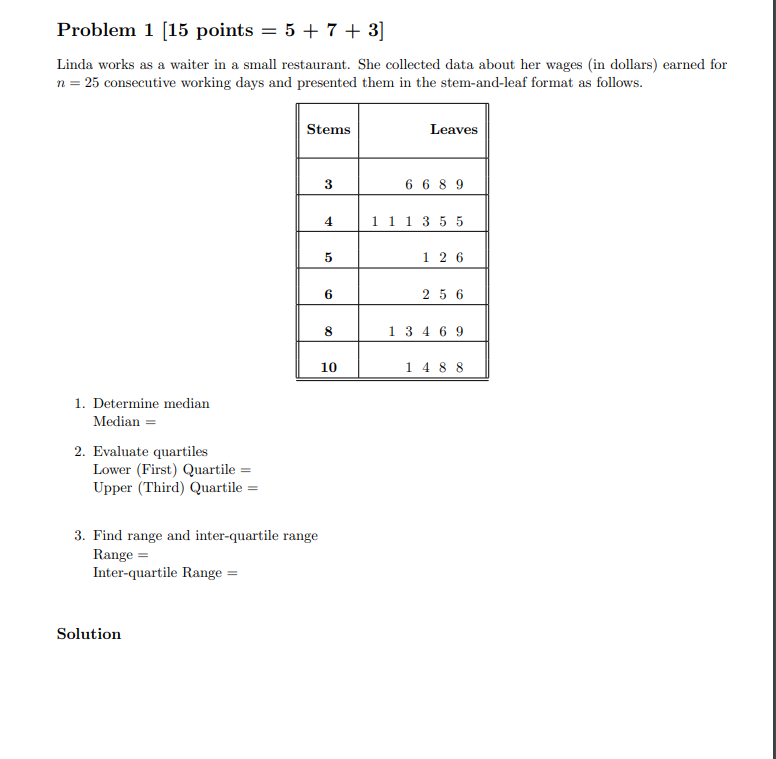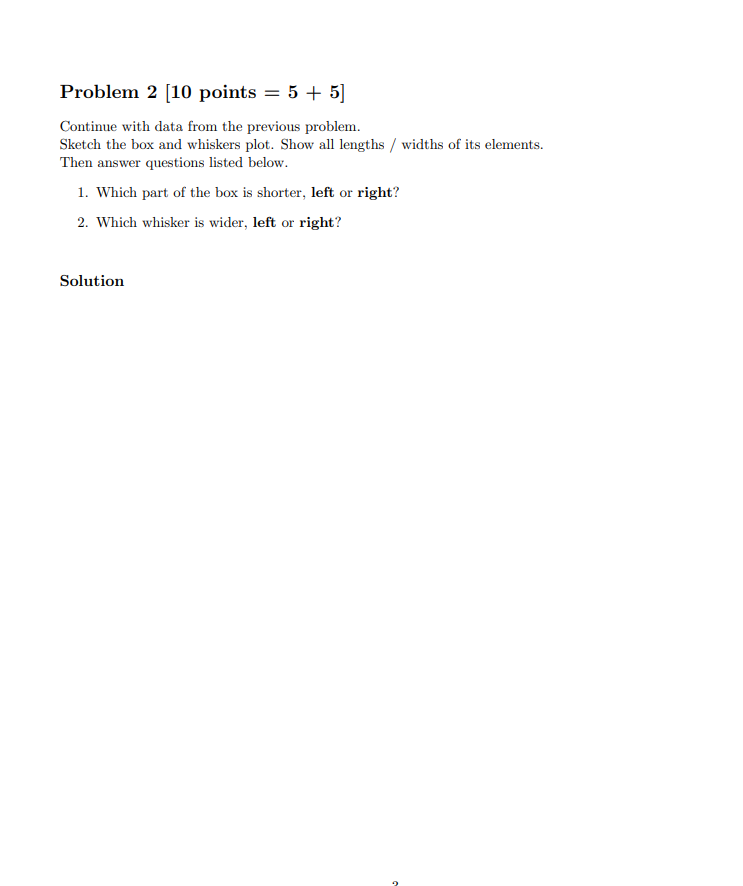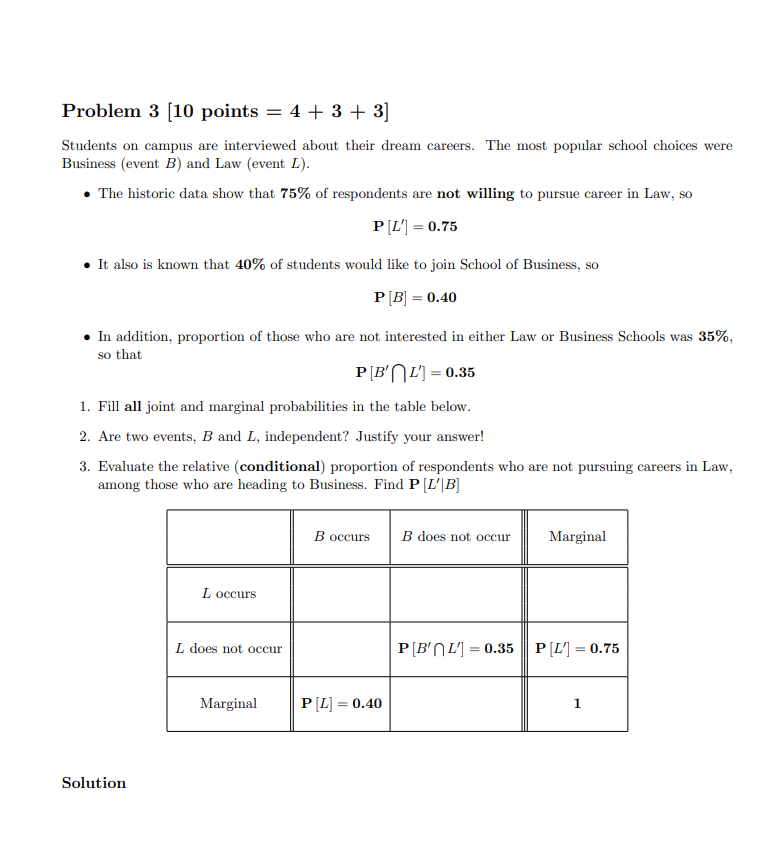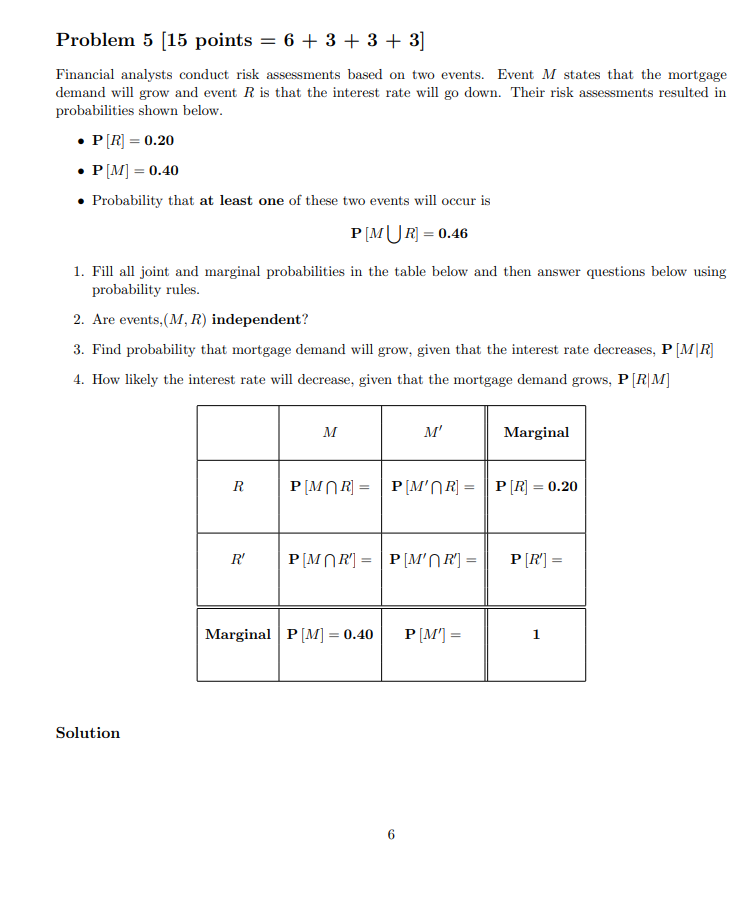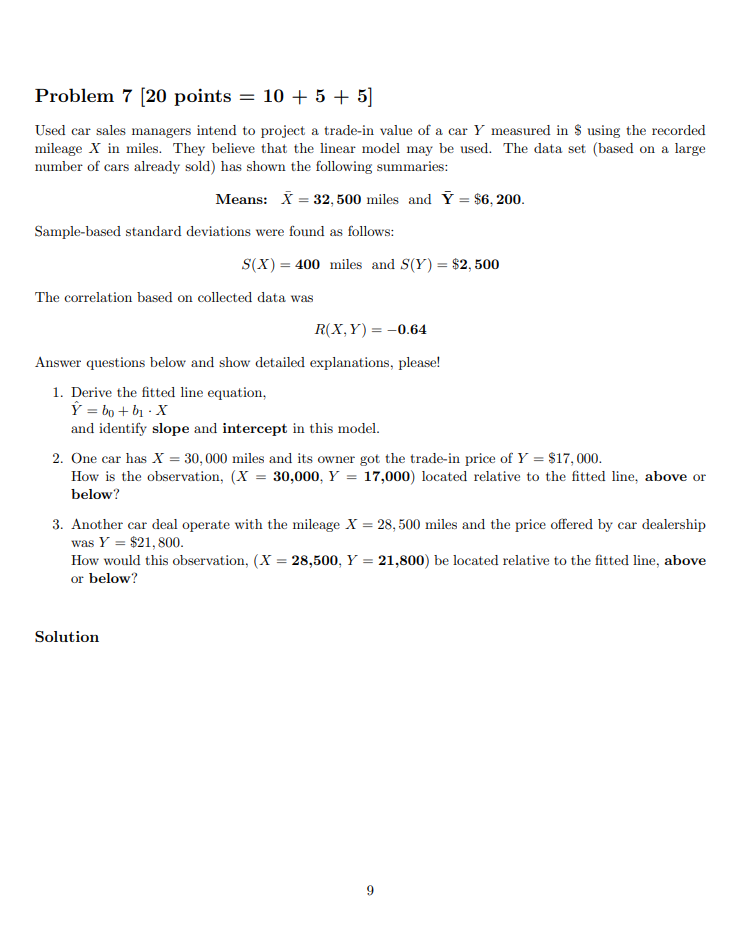Problem 1 [15 points = 5 + 7 + 3] Linda works as a waiter in a small restaurant. She collected data about her wages (in dollars) earned for n = 25 consecutive working days and presented them in the stem-and-leaf format as follows. Stems Leaves 3 6 689 4 1 1 1 3 5 5 5 1 2 6 2 5 6 13469 10 148 8 1. Determine median Median = 2. Evaluate quartiles Lower (First) Quartile = Upper (Third) Quartile = 3. Find range and inter-quartile range Range = Inter-quartile Range = SolutionProblem 2 [10 points = 5 + 5] Continue with data from the previous problem. Sketch the box and whiskers plot. Show all lengths / widths of its elements. Then answer questions listed below. 1. Which part of the box is shorter, left or right? 2. Which whisker is wider, left or right? SolutionProblem 3 [ll] points = 4 + 3 + 3] Students on campus are interviewed about their dream careers. The most popular school choices were Business {event B} and Law {event L}. o The historic data show that 75% of respondents are not willing to pursue career in Law, so P [L'] = 0.75 a It also is known that 40% of students would like to join School of Business, so P [s] = 0.40 I In addition... proportion of those who are not interested in either Law or Business Schools was 35%. so that P [B'L'] = 11.35 1. Fill all joint and marginal probabilities in the table below. 2. Are two events... B and L. independent? Justify your answer! 3 Evaluate the relative {conditional} proportion of respondents who are not pursuing careers in Law, among those who are heading to Business Find P[ [L13] Marginal Solution Problem 4 [ll] points = 4 + 2 + 2 + 2] It is known that proportion of graduate students {event G] is 4% and the remaining 60% are undergrad- uates {event (3"). When a new program {event N] is proposed1 it will be offered to all students. Acceptauee rate is measured as oonditional probability. You are given the following information. o P [NIG] = 0.10 a P[N'|G'] = 0.41] 1. Fill the table of all joint and marginal probabilities below. 2. One student expressed interest in the new program. What is a conditional probability that this was a graduate student? 3. \"What is the proportion of undergraduate students who are not interested in the new program?I 4. Are events {G N} )independent? Justify your answer... please! Solution Problem 5 [15 points = E + 3 + 3 + 3] Financial analysts eonduet rial: assessments based on two events. Event M states that the mortgage demand will grow and event R is that the interest rate will go down. Their risk assessments resulted in probabilities shown below. 0 P [R] = 0.21] o P [M] = H.410 0 Probability that at least one of these two events will ooeur is P[MUR]=L'I.4E 1. Fill all joint and marginal probabilities in the table below and then answer questions below using probability.r rules. 2. Are etents.{M, R) independent? 3. Find probability,r that mortgage demand will grow? given that the interest rate decreases1 P [MIR] 4. How likely.r the interest rate will decrease... given that the mortgage demand grows1 P[R|M] Solution Problem 6 [20 points = 8 + 3 + 3 + 3 + 3] Students enrolled into Actuarial program are expected by the end of their first year to pass one exam of their choice. The options are: M = Mathematics, S = Statistics, and F = Finances. Based on historical records, it is known that 48% of all students take first Mathematics, 32% try to pass Statistics, and remaining 20% focus first on Financial /mathematics. Achievement rate is measured as the conditional probability of event A, given the first exam title. Historical records show that P [AM] = 0.25, P [A|S] = 0.20, and P [A F] = 0.12 1. Fill the table of all joint and marginal probabilities below. 2. Find the overall achievement rate, P [A] 3. Given that Jackie succeeded with her first exam (event A occurred), what is the chance it was Finances? P [FIA] = 4. Given that Lauren did not succeed with her first exam (so event A did not occur), what is the chance that her first exam was in Finances? P [F|A'] = 5. Are events F and A independent? Justify your answer, please! Math Stat Finances Overall A occurs A does not occur Marginal P[M] = 0.32 P [S] = 0.48 P [F) = 0.20 1Problem 7 [20 points = 10 + 5 + 5] Used car sales managers intend to project a trade-in value of a car Y measured in $ using the recorded mileage X in miles. They believe that the linear model may be used. The data set (based on a large number of cars already sold) has shown the following summaries: Means: X = 32, 500 miles and Y = $6, 200. Sample-based standard deviations were found as follows: S(X) = 400 miles and S(Y) = $2, 500 The correlation based on collected data was R(X, Y) = -0.64 Answer questions below and show detailed explanations, please! 1. Derive the fitted line equation, Y = bo + b1 . X and identify slope and intercept in this model. 2. One car has X = 30, 000 miles and its owner got the trade-in price of Y = $17, 000. How is the observation, (X = 30,000, Y = 17,000) located relative to the fitted line, above or below? 3. Another car deal operate with the mileage X = 28, 500 miles and the price offered by car dealership was Y = $21, 800. How would this observation, (X = 28,500, Y = 21,800) be located relative to the fitted line, above or below? Solution 9
